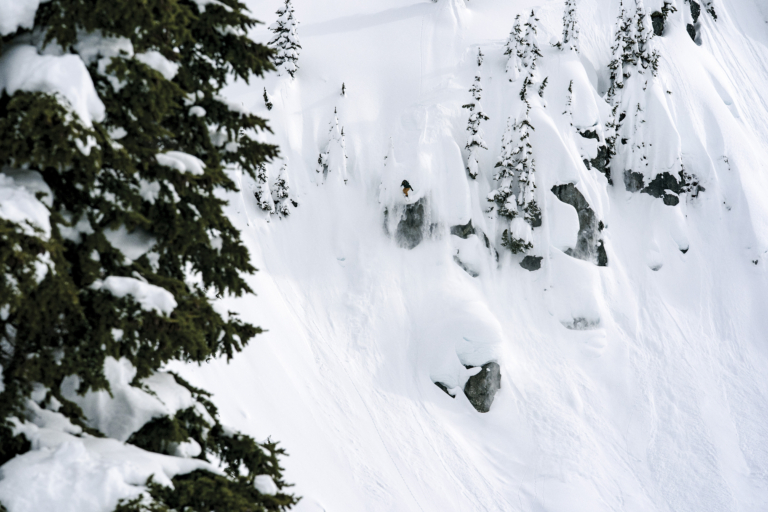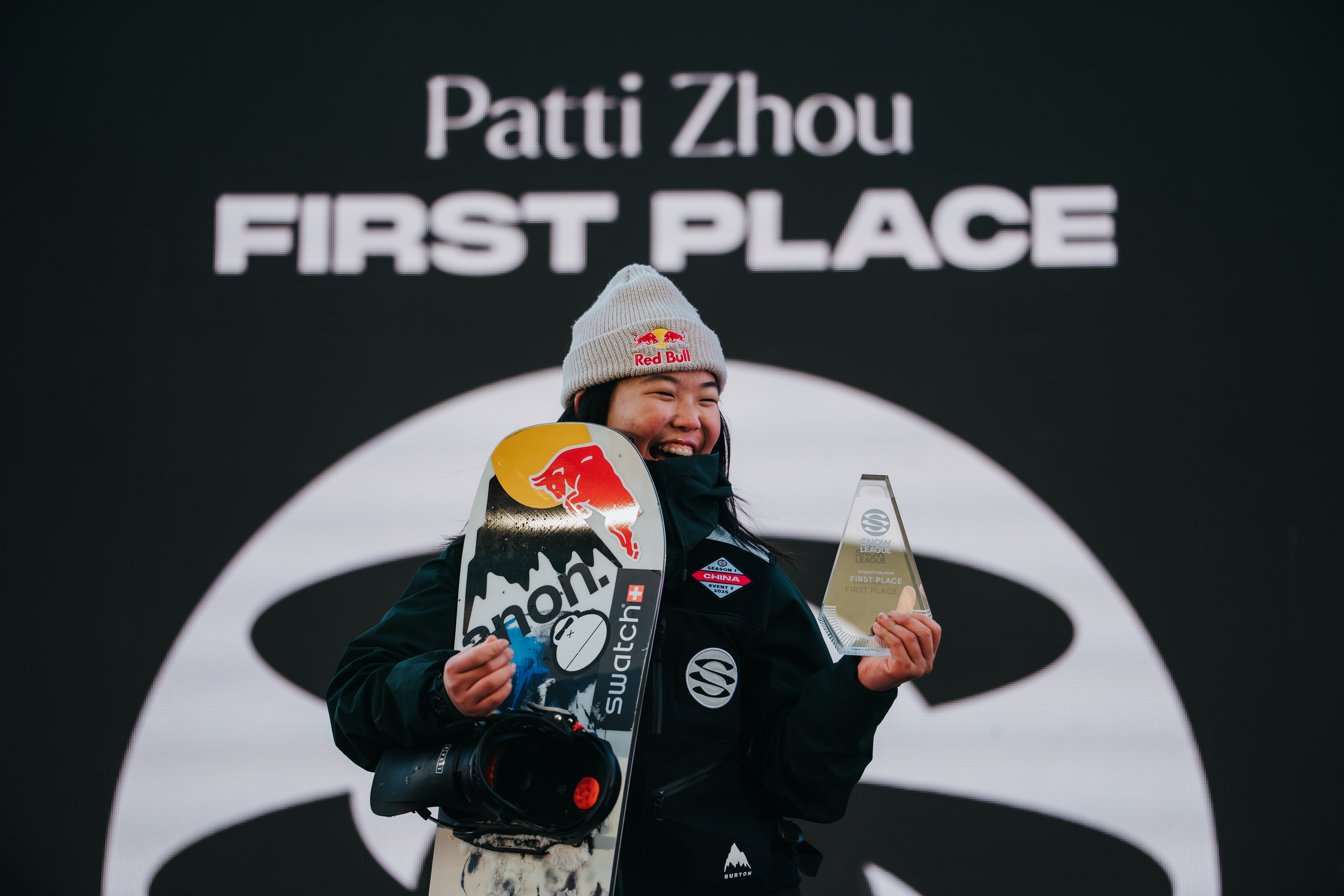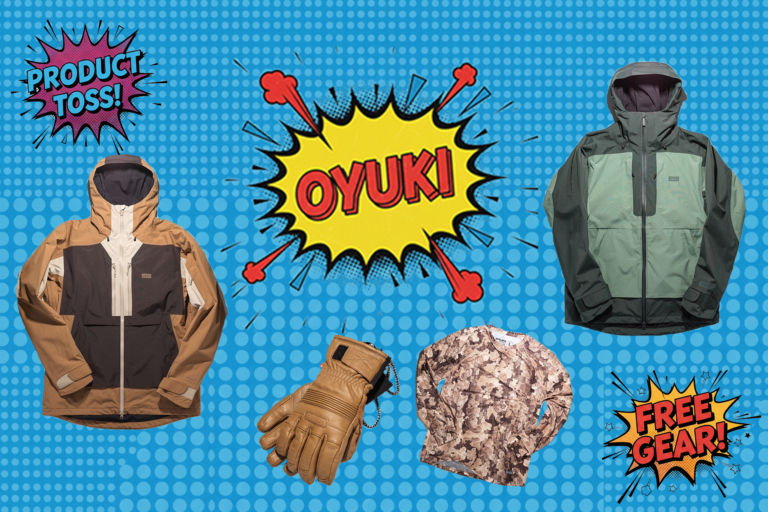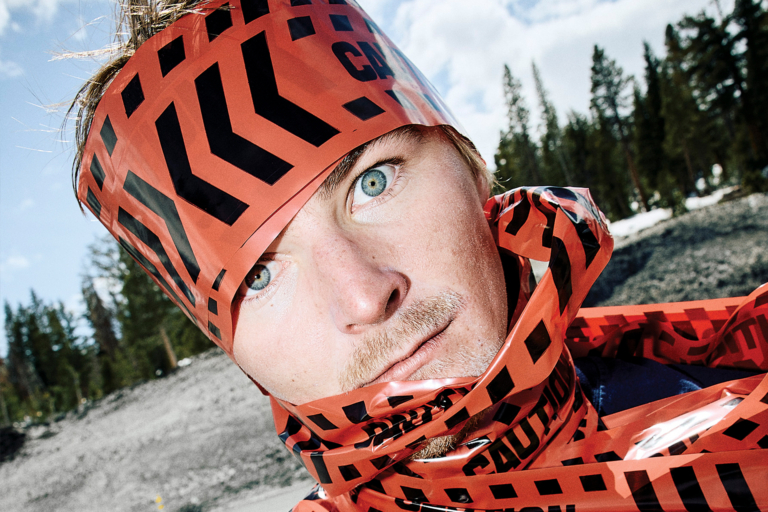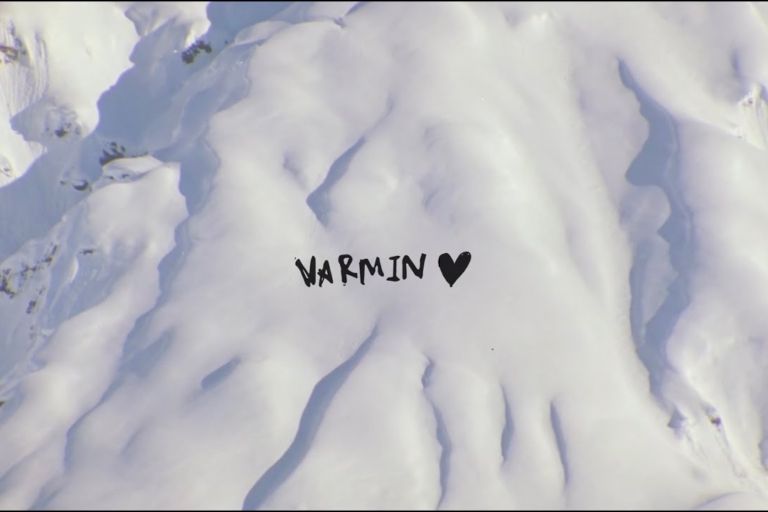At the end of August, we joined the Arbor Snowboards crew on the Big Island of Hawaii to visit the Hawaiian Legacy Forest. We were there to see, firsthand, how the reforestation of native Koa trees is helping to repopulate the ecosystems of Hawai’i. (The feature from issue 19.2 can be read here.) How the simple act of planting a tree–and the concerted effort by many to do this over and over to the tune of hundreds of thousands of trees– has brought back waterways, species of birds and insects, and contributed to an environmental well-being that is growing rapidly and affecting things on greater scale. While for most of us, it was our first time visiting the Hawaiian Legacy Forest, for Marie-France Roy, it was her second trip to contribute to the reforestation efforts. Being in Hawaii with Marie was a special thing; she has always had an affinity for the earth and the species that inhabit it–she studied this in university before she became a professional snowboarder–and her perspective on the environment, activism, community, and the intersection of these things is knowledgeable, humble, and full of empathy and consideration. We sat down while in Kona to talk a little about the Legacy Forest and her experience affecting change in different ways–through activism, the West Coast Triple Plank, contributing to scientific study, and more, which is a lead-by-example of the many ways that a positive difference can be made to the places and communities we love. Marie’s hope for what is possible is both hopeful and pragmatic, which drives a deep understanding of how to move forward in a sustainable way. One of the underpinnings of it all, Marie underlines that the more we release pressure on ourselves to not be perfect while working toward our goals, and if we can find ways to have fun while doing so too, the better we can forge ahead. – Mary T. Walsh

So, what are you doing in Hawaii?
We came to Hawaii, for the second year in a row, to visit and take advantage of experiencing what the Hawaiian Legacy Forest is all about and the Returning Roots program that Arbor started a long time ago. Last year, Guch, Grayson, Dave, and I came here and we are back this year with Erik, Mary, Yosh and the evo guys. It’s been a really cool experience to share with everyone. To get to see it firsthand, you start to really understand the impact of this type of initiative, and it’s awesome.
You do a variety of different things to contribute positively to the environment where you live in British Columbia. Comparatively, what is it like to come to a totally different ecosystem and see some of the work that’s happening here, like the Legacy Forest?
Totally. That’s exactly what it reminded me of when I first came last year, because I had never been to Hawaii before. To see what they’re doing here compared to what’s happening at home and some of the different initiatives I’ve been involved with, it’s a very similar foundation around the values and what they’re trying to do, but maybe just different approach that is equally important and interesting to learn from.
I was really stoked to see it firsthand because you always hear of companies doing a giveback, planting a tree and stuff like that, but I was really, really amazed by how Arbor and the Legacy Forest are doing it here. They’re not just planting a tree randomly at a place where it’s just been logged before. They’re planting Koa trees and they’re planting whole ecosystems and they’re managing that forest in the long term. To me, that’s a lot more meaningful.
At home, I don’t know, I’m involved with so many different things, but I think it’s so exciting to see what everybody’s doing around the world. People might not understand why Arbor chose Hawaii, but the Koa tree, which is the Arbor logo, is what the first surfboards were made from. So as the snowboarders, surfers, and skateboarders, we’re deeply connected to that culture and to that tree itself. And Arbor uses a lot of wood, obviously, in their snowboards so it all makes sense and it all goes back to where it started.
Have you taken anything away during your experience in Hawaii this year compared to your visit last year?
Well, I think every time you visit a place like this, it’s pretty short term—we were here for a few days last year, three days this year—so every time you come back, you only can take in so much information. But what I didn’t realize last year is that these trees that have been planted are only 11 years old. I thought these trees were 40 years old [editor’s note: based on how large they are already]. To me, it just shows that when a team of intelligent, passionate people come together and start something, believe in it, and do the right research, how much of an impact you can make.
The Legacy Forest is bringing back hawks and owls and native species of plants—and this has happened in only eleven years. I think that that’s a lesson for us on earth, in general, too. We’ve been making such a big impact as human beings and it’s so depressing sometimes to think about all that harm and the direction we’re going. It’s not slowing down nearly fast enough. But to me, these glimmers of hope are so important, because it just shows that in eleven years, when you do care and when you do get involved, it can make a huge difference. And that’s going to inspire more people.
Imagine if every company in the world, not just in action sports did something like this? Arbor’s doing great [with this giveback], but there’s even more potential. Imagine if there were regulations around how every company operates in making a profit, maybe have to put a certain percentage into giving back. Right now, it’s definitely not the case. It’s even 1% for the planet, right? Which is a huge reward for most companies, something you’re really proud of. It’s just 1%. Imagine if we had 10%. I don’t know, I just find it interesting to think about. Visiting these places and seeing companies taking these projects on gives me hope. That’s so important nowadays.
I remember one of the things that you shared last year in your interview in the mag was that if you are too scared of being perfect, in terms of your own actions and how they affect the planet, you become frozen. You can’t do anything. None of us are going to be perfect, but that there are still different positive actions that we can make, whether as a company or an individual.
Yeah. First of all, there’s about maybe half the population that doesn’t care at all, whatsoever. Don’t even believe there’s change or that we’re affecting our playgrounds or Mother Nature and what gives us life in the first place. So right there, there’s 50% that don’t believe. And then I don’t know what the percentage is of people who are frozen exactly because they care. They want to do something and they’re depressed, but they just feel like they’re not perfect enough. And then there’s another group of people that care, but they’re so harsh on the people trying because they’re not perfect. So at the end of the day, everyone’s freaking frozen or not caring, because nobody can be perfect, but if we could let go of that guilt and that judgment of each other of not being good enough, how much more could get done? It would be incredible.
I think it’s our biggest enemy. Every little thing that gets done, even if it’s considered green washing in so many ways, is a brick in a wall that more people can put their own bricks into. That’s the only way to get there. Nobody’s going to save the world alone or with just one company. It’s impossible.
And a part of it too is what can be done on the legislative level. Like in the US, the IRA bill that was just passed. And it’s still not as much change as a lot of people wanted, but we’ve got to start somewhere really.
And even getting that was so hard because you still have part of the population that doesn’t want that. So how do you make progress? We need more education and we need more people starting things, even though they’re not perfect and getting involved the best we can.
Can you share a little bit about your work with Protect Our Winters Canada?
I’m on the board of directors. It’s been really exciting. We are getting more into politics and policy regulation, slowly getting a seat at the table as we grow our membership. And our staff, everything has been growing so much. We just got a new executive director. Dave Erb was there before. He was amazing. POW Canada wouldn’t exist without him. But it’s been a lot of good learning. And even with that work, people have different opinions of campaigning. What is important? How are we going to reach our goal? What is our goal? We just had a huge meeting about that. Of course, our goal is to unite action sports on climate change, but what is the best way to do that?
So we try to have different ways to do this, whether it’s education with grownups or youth. But we’re trying to get more into policy and growing our membership is a big priority because then it really has a bigger weight on the policy side of things.
Not to change subjects completely, but you’ve also done a lot of work with the old growth forests in British Columbia. Could explain a little bit about what you have been doing with that?
Totally, yes. I mean, this is one of the points too—everyone has a different way to activate. Some people, it’s going vegan and some people it is being involved in policy or joining an organization. And some people, it is protesting and getting arrested. I love to experiment with all those different avenues. Last year with the movement about old growth in BC, that was such a good opportunity to join a cause that had momentum, because I know a lot of people have been fighting for that cause for decades and there was nothing moving.
And all of a sudden last year…it’s not perfect yet, there’s still old growth logging happening, but for the first time, it definitely shook some doors. There were some changes being made. Of course it’s slow and it’s never enough and never quick enough, but it shows the power of people coming together. It was scary at times. In a way it was my favorite way to activate because it was so gnarly. You’re on the ground. You’re not sleeping all night. You’re digging trenches. You’re sleeping in a tent with strangers you just met. You biked that night in the rain with a 30-pound cement bag on your back. You’re going to dig all night so that someone can chain themselves in the morning when the cops show up.
Of all the activism I’ve been involved with in my whole life, that definitely was the most powerful and the most rewarding in the terms of having hope. Because you do all these activations and events and it’s “Yeah, I care.” They’ll give 10 bucks, they’ll have a couple drinks and go home. But at the end of the day, life goes on. But there you had people, single moms who had quit their jobs just to be there for this cause. The old growth is one thing, but it represents the state of the world. It could be the same with any cause you have, whether it’s coral or oceans or fish or I don’t know, ecosystems anywhere. Or even health issues, all the disease we’re fighting and cancer. Where do you think that comes from? It’s just a reflection of what we’re doing to the earth and whatever chemicals and things we put in the earth ends up in our bodies and we’re suffering from that. I think that it’s all so closely related and that’s why I’m like, “We are the privileged ones. We have all the tools and we benefit so much from nature. Come on, let’s activate. Give a little.” And sometimes, I’m exhausted. I need to take some time for myself and actually just go have some fun, which I did a lot this summer. And then I go back in nature and it recharges me and I’m like, “Okay, I got to go back at it. What am I going to do next to give back?” What you give comes back tenfold. You recharge and you come back.
So much of what you work on intersects with the community as well, whether it is directly through environmental activism or through other programs and events. This past summer, you did a session with the youth camp that your partner runs, right?
I did a few sessions. So my partner, Timmy Taussig—he’s amazing, he’s a frother—two years ago he and his friend, Nick Jacobson, started Camp Stoked. Initially they just wanted to bring more youth to surfing and skateboarding. Eventually, they got the opportunity to work with some Indigenous communities back home on Vancouver Island. A lot of the kids don’t get the opportunity to skateboard. Most of them don’t have skateboards—they barely have shoes. So, I’ve been volunteering with them and it is life changing. Seeing how welcoming the kids are, and also listening to the stories of what they’ve gone through—just being there, listening. It’s just been mindblowing. I recommend it to everyone, to not be judgmental towards Indigenous communities and just listen. Start making friends. Make connections because that’s the only way we’re going to heal together. Those kids are amazing. They have no fear and they’re so awesome. After all that happened in history, of course there’s a lot of resentment and distrust in general in the communities. It is going to be extremely hard to rebuild. But when you put two kids from different backgrounds together, no matter what the history was, they’re going to fix it. It’s going to take time, but it’s the best way to work through long term conflicts, I find.
Is there anything else you’re currently involved in or that you’re seeing makes you stoked in terms of community and positivity and change?
The Triple Plank gives me so much stoke because it’s a way for our crew to give back and connect all the dots—connect our love for snowboarding, skateboarding, surfing and this amazing playground that we have, but then bring people together and give back at the same time. We’re raising money for Redd Fish Restoration Society. Their work is a lot around salmon stream restoration, but it’s the whole ecosystem that comes with it, all the way from the forest to the soils, to the river, to the ocean, and the whales and everything. They’re such a sick crew. They’re amazing, young, talented people. Lots of women, lots of Indigenous folks that are working together along with loggers, scientists and people from the community. They’re slowly fixing the whole ecosystem. We raised close to 25 grand last year, plus the years before.
How many years have you been doing the Triple Plank?
Four. Also, I’ve been working part-time with Redd Fish this past summer on kelp surveys. I’ve been droning.
Oh, you’re droning!
I’m so bad, ha, but we are making drone maps. We’re basically doing studies about the kelp and the kelp habitat. We don’t have baseline data on what the kelp’s been doing in the Barkley Sound, so we want to establish what’s there every year and then we can compare and see if there’s decline or increase.
That’s so cool.
I mean, that’s what I studied and so for me, I want to work part time. It’s been incredible. I also applied for a kelp farm three years ago, and they just updated me that I got approved for the first part of the process.
That’s amazing. Congratulations!
Thank you. It is amazing. The other parts will take two to three years, so we’ll see. It’s a long play and there’s no guarantee it will happen, but I find that sector really exciting. I don’t know what we’ll make with it. I want it to be a collaborative effort. I have found that it’s all about adapting to what’s around you, what skillset you have, what you have available to you—and something that will be fun for you at the same time. And then going from there.

